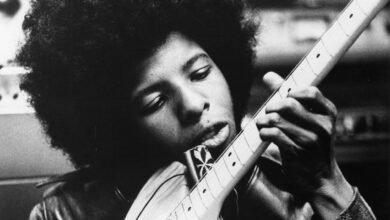
The prime success of the new movie version of “The Color Purple” is its tone: it plays like legend, filtered through the pleasure and the pain of the telling. It’s a musical, adapted from Alice Walker’s novel and from Marsha Norman’s book for the stage play (which is also a musical and provides the new movie with most of its songs). The interjections and interminglings of the musical sequences in the drama endow the story with narrative distance along with its emotional immediacy; this distance from within seemingly conveys the very notion of adaptation, the feeling of tales retold, reimagined, relived. The movie’s director, Blitz Bazawule—making only his second feature, following his ultra-low-budget dramatic fantasy “The Burial of Kojo,” from 2018—catches the sense of mysteries and wonders in his characters’ lives, which are filled with extremes of sorrow and joy, with deep bonds of love, with enduring traditions, with collective memories spanning the land and baked into the bone.
Bazawule starts the movie with a symbol clash—the overhead view of a man on horseback, bearing a banjo, ambling slowly along a hard-baked dirt road, passing two girls in white dresses sitting in a tree and singing playfully, on Sunday morning, fretting about being late for church—as, moments thereafter, a nearby group of women in backlight make their way down the road singing a rollicking gospel-inflected song. From the start, Bazawule suggests the conflicts between secular and religious Black American culture, between the spirit and the flesh, and between men’s and women’s worlds—and he does so by way of a crucial reference to one of the great works of art on these very themes, Julie Dash’s 1991 film “Daughters of the Dust.” Bazawule’s adaptation of “The Color Purple” is set mainly in a small town on the Georgia coast; the story runs nearly forty years, from 1909 to 1947, and many of its images pay visual and tonal homage to Dash’s movie (her sole Hollywood feature to date)—women on the beach, wearing white and light-colored lacy dresses, amid sere and stark trees, gathering spontaneously in formations of a hieratic splendor. (Even the image of the two girls that’s part of the movie’s extended and swooping first shot is a nod to a similar one from Dash’s film.) With “Daughters,” Dash places Black Americans’ intimate dramas in a mighty historical arc with metaphysical dimensions; with his “Color Purple,” Bazawule acknowledges Dash’s work as a landmark in that history and a fundamental inspiration in his approach to historical drama.
The story sticks close to the one that’s familiar both from the novel and from Steven Spielberg’s 1985 film. A teen-aged Celie Harris (Phylicia Pearl Mpasi) has been raped by her (ostensible) father, Alfonso (Deon Cole), and bears him two children, whom he forcibly takes from her with hints that he has killed them. Her one companion is her studious sister, Nettie (Halle Bailey), whose storytelling brings to mind memories of their late mother (Aunjanue Ellis-Taylor). The man on horseback at the start of the film, Albert (Colman Domingo), who calls himself Mister, marries Celie and brutally abuses her, physically and emotionally; Alfonso tries to rape Nettie, who runs away to Celie. When Mister tries to rape Nettie, she resists and he throws her off his property, vowing to keep the two sisters separated forever. The action progresses to 1917—Celie, as an adult, is played by Fantasia Barrino—and Mister’s son Harpo (Corey Hawkins) marries a sharp-witted, independent-minded woman named Sofia (Danielle Brooks), but the couple soon separates (Celie bears some guilt in the matter). Harpo turns their house into a juke joint, and when Mister’s once and again lover, Shug Avery (Taraji P. Henson), a blues singer, comes back to town, she performs in the club. She also helps Celie to resist Mister’s abuse, taking Celie with her to Memphis; the two women become lovers. But through the years of agony that Celie endures, she is desperately deprived of contact with Nettie. She also has signs and premonitions that her two children are actually alive, but has little hope of reuniting with them.
Bazawule’s film doesn’t stint on the complex and often grim circumstances, both political and intimate, of Celie and her extended circle of family and friends in the rural South in the early twentieth century. There’s much more to the teeming story—including the horrifying result of Sofia’s resistance to insults from local white grandees; Shug’s alienation from her father, the community’s minister (David Alan Grier), for forsaking church music for the blues; Harpo’s extramarital relations; Celie’s consideration of violence to escape from Mister; the power of a curse, the revelation of long-suppressed family secrets, and the restored connection between Black Americans and modern Africa. The script, by Marcus Gardley, unfolds the story with attention to its thematic and metaphorical dimensions—the ambient threats of lynchings and the use of brutal incarceration as racist domination in the Jim Crow era; the mystical and quasi-metaphysical relationship to nature that’s a part of country life; the powerful collective memory of enslavement that’s passed down from generation to generation; the connection of American white supremacy with European colonial policies and the deformation of civic institutions to sustain it.
With the refined embellishments of his perceptive direction, Bazawule puts incidents and their implications into high relief; he displays an elegance and an exuberance that have long shadows, framing rugged practicalities and intimate gestures with fervent empathy and lyrical grace. Scenes of imagination and fantasy—as when Mister’s house fills with multiple Celies, and when she watches a movie with Shug (with an all-Black cast, part of the burgeoning Black cinema of the era) and envisions them on the screen—play like interior monologues in action. As for the musical numbers, Bazawule reaches far beyond the conventions of recent Hollywood norms to endow them with style to go with their energy. He’s a longtime musician (performing as Blitz the Ambassador), and his filming of the production numbers (choreographed by Fatima Robinson) turns them into a kind of visual music, rich in rhythmic variety, contrapuntal motion, and even something like phrasing—especially in several sung and danced spectacles featuring long and graceful takes, where the complexity is no mere showcased virtuosity (as in Spielberg’s “West Side Story”) but dynamically lyrical geometry with sharp lines and sinuous curves.
Source link







